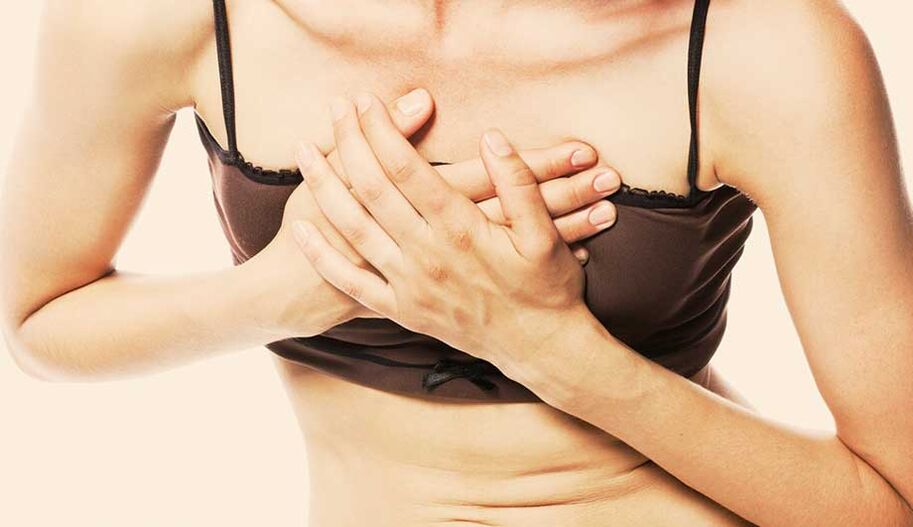Osteochondrosis is a very dangerous disease. It occurs invisibly, and from a mild uncomfortable sensation develops into a serious disorder of the spine, which sometimes results in deformity.

Therapists, neurologists, orthopedists, vertebrologists and other specialists are involved in the treatment of this disease.
Symptoms and sensations of chest osteochondrosis
Osteochondrosis of the thoracic spine is less common than osteochondrosis of the cervical or lumbar spine. The thoracic vertebrae are less mobile and more insulated. The disease is complicated by the fact that symptoms are difficult to identify, and in turn this can lead to a number of other diseases.
One of the main reasons for the appearance of osteochondrosis of the thoracic region is the presence of scoliosis in humans. With curvature of the spine, the pressure on the vertebrae increases and there is displacement and loss of their discs from the spinal space. The pain that occurs with this disease is indicated by the fact that changes take place in the vertebrae, metabolism and blood supply are disrupted. The disease affects most people who lead an inactive lifestyle, office workers, drivers, students.
With thoracic osteochondrosis, symptoms and sensations are divided into major pain syndromes: dorsago and dorsalgia. Dorsalgia is a mild prolonged chronic pain and brings little discomfort to the patient. Dorsago is a sudden and sharp pain. It occurs when a person is in a certain position for a long time and dramatically changes it. Shortness of breath may appear, difficulty breathing, poorly controlled muscles.
Thoracic degenerative disc disease: symptoms and sensations are typical and uncommon
Osteochondrosis of the thoracic region, like other diseases, has a number of special features. List of special symptoms:
- painful sensation increased while inhaling, turning the body, raising the hands upwards;
- the pain begins in one place, and then quickly spreads to the rest of the chest. Hard to breath. The patient had to find a comfortable position. Intercostal neuralgia occurs;
- muscles are very tense, spasms occur periodically;
- the precursor of intercostal neuralgia is recurrent pain, an uncomfortable sensation in the back and chest that occurs when walking or exercising;
- the pain syndrome increases at night, in the morning it can subside completely. It also becomes noticeable during hypothermia.
For osteochondrosis of the thoracic region, symptoms and sensations are features that are characteristic of other diseases. Such symptoms are called atypical. This includes:
- painful sensations similar to diseases of the cardiovascular system. While taking the medication, there is no improvement, and can even worsen the health condition. Also, with the ECG, no changes were observed;
- for women in the acute stage of development of the disease, pain in the mammary glands is characteristic. You can rule out this pathology by visiting a mammologist;
- sometimes patients complain of painful sensations such as pain in gastritis, ulcers, diseases of the gastrointestinal tract. But, unlike these diseases, with osteochondrosis, the pain increases during the moment of load, and not during eating;
- disorders of the urinary and reproductive systems;
- some patients have difficulty swallowing reflexes, a feeling of "bumps in the throat".
With chest osteochondrosis, treatment is needed immediately, and self -treatment is unacceptable. This can lead to deterioration of the patient’s condition, and subsequently even disability. Specialists can identify the symptoms of the disease and the typical of the disease. Qualified doctors diagnose thoracic osteochondrosis using modern equipment and treat it using the latest effective methods.
Chest osteochondrosis: symptoms and treatment
Hospitals use the best schemes and methods for the treatment of chest osteochondrosis. Medication methods help eliminate inflammatory processes and relieve pain. The main method of dealing with osteochondrosis is the use of chondroprotectors for a long period of time. They restore the cartilage of the intervertebral disc, its elasticity. For hospital patients, a prerequisite of treatment is exercise therapy to strengthen the musculoskeletal-ligament. Muscle relaxants are used (relieving muscle spasms), non-steroidal anti-inflammatory drugs.
To maintain overall balance, increase metabolism in the body, proper nutrition is needed. Hospitals provide nutritionist and inpatient services, where it is much easier to maintain a healthy lifestyle during the recovery period than at home.
Among the additional treatment methods used:
- acupuncture;
- massage;
- physiotherapy;
- manual therapy;
- vacuum therapy.























